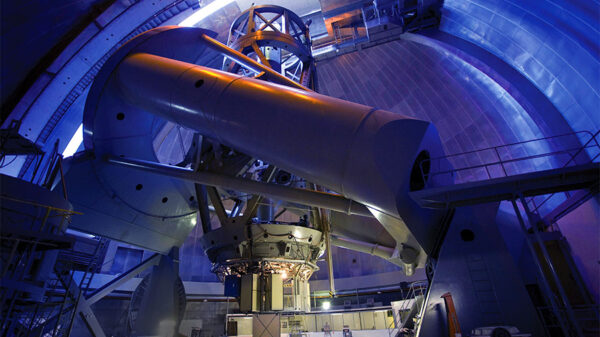The holidays have arrived once again and 2024 is nearly over so we’ve decided to put together a compilation of the year’s best. These are organized by sector, and the highlights show the primary narratives that either we directly chased or that emerged as the year progressed.
It was originally going to be Top 5, but we couldn’t choose. So expect to learn about optimal cancer fighting technology, and follow the shadowy underworld of artisanal gold mining. Also you can expect to delve into questions about whether technology is a net positive or negative or humanity, and there’s even a garden gnome made entirely of MDMA.
We’ve managed to make another spin around the sun and we’re coming around to a new January with new challenges and complications ahead. Join us for our best of 2024.

YouTube screenshot. Image via Breath Diagnostics.
The fight against cancer
Cancer is a global health crisis with profound human and economic consequences. It ranks as the number one or number two leading cause of death in most countries worldwide.
Globally, cancer claims nearly 10 million lives annually, according to the World Health Organization (WHO). In Canada, cancer remains the leading cause of death, responsible for nearly 30 per cent of all fatalities, with lung, breast, colorectal, and prostate cancers being the most common diagnoses. These numbers show the depth and gravity of what is clearly a public health priority.
Lung cancer, in particular, epitomizes the challenges of cancer control.
It is the deadliest form of cancer globally, accounting for about 2.2 million new cases and 1.8 million deaths annually. Small cell lung cancer (SCLC), a highly aggressive form, presents unique hurdles.
The prognosis for SCLC remains grim because most cases are diagnosed at advanced stages, leaving limited treatment options. Early detection is vital for improving survival rates, yet many individuals delay seeking medical attention until symptoms become severe.
Factors such as fear, stigma, and lack of access to healthcare services compound this issue.
Efforts to promote early diagnosis are crucial but require more than awareness campaigns. Emerging technologies are pivotal in revolutionizing how we detect lung cancer. Innovations like the One Breath technology from Breath Diagnostics offer hope for facilitating early detection.
This non-invasive diagnostic tool analyzes a patient’s exhaled breath for biomarkers associated with lung cancer, potentially identifying the disease before symptoms appear. Such advances aim to make screening more accessible, affordable, and less intimidating, thereby encouraging broader participation in early detection programs.
Read more: Breath Diagnostics takes aim at lung cancer with One Breath
Read more: The five front war against cancer: A mugglehead roundup

Image via Grok.
All that glitters is gold
Gold has been one of the biggest ongoing sagas from 2024.
The precious metal has solidified its role as a safe haven asset in uncertain times, with prices hovering near and regularly beating all-time highs. The reasons why are varied but tie into the idea of gold as a safe haven asset.
Geopolitical instability has fuelled global uncertainty. As such, gold became an increasingly attractive asset for central banks looking to hedge against geopolitical risks.
Meanwhile, on the other end of the wealth spectrum, predatory factions like the Wagner Group in Russia and the cartels and illegal organizations in Central and South America and the African continent take advantage of the vulnerability of the disparate populations of countries for their own ends.
But gold’s stellar year can’t be laid at the feet of geopolitical factors alone.
The persistent challenge of inflation has kept gold’s allure intact. Central banks worldwide grappled with balancing interest rate hikes to combat inflation while avoiding economic slowdowns. The Federal Reserve’s cautious approach bolstered gold’s appeal as a store of value. Furthermore, the European Central Bank’s struggle with inflation and energy crises added to gold’s demand.
Gold’s performance in 2024 reverberated across peripheral industries.
The jewellery market benefited from sustained consumer demand, particularly in emerging economies like India and China, where gold remains deeply ingrained in cultural traditions. High prices encouraged recycling and secondary market activity, partially offsetting the cost burden for consumers.
For gold mining companies, elevated prices mean more profits, exploration and interest in regions like Australia, Canada, and Newfoundland—home to Calibre Mining Corp. (TSE: CXB) (OTMRKTS: CXBMF) expanding operations.
Read more: All that glitters is gold: A Mugglehead roundup
Read more: Wagner Group funds Russian war with illegal gold mining proceeds

Image via Grok.
The line separating good and evil runs through the heart of every man
The convergence of artificial intelligence (AI) and blockchain technology is possibly one of the strongest innovations of 2024, easily with the most promise. But it’s also raised concerns about their darker implications.
One alarming aspect is their potential to deepen surveillance. AI systems, when combined with blockchain’s immutable records, can provide governments and corporations with unprecedented tools to track and analyze individual behaviours.
Central Bank Digital Currencies (CBDCs), built on blockchain, could amplify this trend in 2025.
Governments could use CBDCs to monitor economic activity at a granular level, potentially enabling invasive surveillance of personal spending habits under the guise of fighting fraud or ensuring financial stability.
The rise of crypto-related crime exemplifies another dark side. Blockchain’s pseudonymity, while offering privacy benefits, has become a playground for illicit activities. Ransomware attacks, in which hackers demand cryptocurrency payments to unlock encrypted data, have surged globally.
Additionally, the kidnapping of Wonderfi Technologies Inc (TSE: WNDR) CEO Dean Skurka shows how criminals are targeting individuals in the crypto industry for direct financial gain. The decentralized and often opaque nature of blockchain technology makes such crimes difficult to trace and prosecute.
However, these technologies are not inherently malevolent and have been harnessed for societal advancement.
AI is revolutionizing healthcare by enabling early disease detection and personalized treatment plans. Blockchain is fostering transparency and trust in supply chains, ensuring ethical sourcing and reducing fraud. Together, AI and blockchain can combat corruption by streamlining public records and financial transactions, promoting accountability.
Read more: Five ways blockchain and artificial intelligence are made for one another
Read more: Cryptocurrency company CEO gets kidnapped and ransomed in Toronto

Šefcovic speaks in Brussels on Apr. 11. Image credit: Euractiv
Alternative energy and the green transition
Alternative energy is at the heart of a global transition, but the journey has its challenges. The lithium supply glut is a case in point.
The oversupply from mining projects outpacing demand has led to falling prices, squeezing margins for producers and complicating plans for electric vehicle manufacturers who rely on stable supply chains. This volatility raises questions about long-term viability, especially as electric vehicles aim to scale globally.
Meanwhile, green hydrogen, hailed as a zero-emissions fuel, is gaining momentum. Investments in electrolysis technologies and renewable energy integration highlight its potential to decarbonize sectors like heavy industry and transportation. However, high production costs and limited infrastructure remain significant hurdles.
The spotlight, however, is increasingly on nuclear energy and its next-generation technologies. Small Modular Reactors (SMRs) and microreactors offer innovative solutions. Westinghouse leads in SMR development with its eVinci microreactor, which promises scalability and efficiency.
These compact systems could revolutionize energy grids, particularly in remote or underserved areas, by providing consistent, low-carbon power.
As with most things of this nature, geopolitics has a part to play.
The U.S. Senate’s push to shift uranium sourcing away from Russia, coupled with Russia halting uranium trade, puts the fragility of global energy security on display.
This pivot is part of a broader strategy to reduce dependence on adversarial nations for critical resources. It creates opportunities for allies, particularly Canada, to step in. Companies like Cameco Corp. (NYSE: CCJ) (TSE: CCO) may find themselves pivotal players in filling this void.
Read more: Two new nuclear plants required annually for next 15 years, European Commission says
Read more: Russia shuts off uranium supply to United States

Master grower Andrew from Ontario’s small batch cultivator Carmel. Photo: Rowan Dunne
Cannabis languishes in legal limbo in the United States
The cannabis industry in 2024 faced significant recalibration as companies navigated a mix of challenges and opportunities.
Declining wholesale prices, oversupply, and regulatory hurdles continued to pressure profit margins, forcing many operators to consolidate or shift strategies. However, advancements in product diversification, including cannabis-infused beverages, edibles, and wellness products, helped some firms find new revenue streams.
Additionally, international markets, particularly in Europe and Latin America, provided growth opportunities as legalization gained traction.
The U.S. market remained a focal point, with ongoing efforts to pass federal reform.
While full legalization eluded lawmakers in 2024, bipartisan discussions about banking access and tax relief for cannabis businesses signalled potential progress. States like New York and New Jersey saw their legal markets mature, though some struggled with competition from entrenched illicit operators. Canada’s market, meanwhile, remained stable but saturated, prompting major players to seek opportunities abroad.
Looking ahead to 2025, several trends are expected to shape the industry. Increased automation and technological innovation in cultivation and processing aim to reduce costs and improve quality.
The potential for federal reform in the U.S., particularly around banking laws, could unlock new investment opportunities and facilitate mergers and acquisitions. International markets are poised for expansion, with Germany expected to lead Europe’s cannabis revolution.
The cannabis industry’s trajectory in 2025 hinges on adaptability and innovation. Companies that prioritize efficiency, product differentiation, and strategic international partnerships are likely to thrive as the global landscape continues to evolve.
Read more: KIND Gardens cannabis show lights up Vancouver for the first time
Read more: Canadian cannabis leaders bring their concerns to Parliament Hill’s doorstep

Not your average. Photo credit: Politie Basisteam Dongemond via Facebook
Psychedelics endures significant setbacks in 2024
The psychedelics industry has garnered significant attention for its potential in treating various mental health conditions. Substances like psilocybin and MDMA have been studied for their efficacy in addressing disorders such as depression, anxiety, and post-traumatic stress disorder (PTSD). Clinical trials have indicated that psychedelic-assisted therapies can offer relief, particularly for patients unresponsive to conventional treatments.
In 2024, the industry faced notable setbacks. In June, an FDA advisory panel voted 9-2 against approving MDMA-assisted therapy for PTSD, citing insufficient evidence of its effectiveness.
Subsequently, in August, the FDA formally rejected the application for MDMA’s use in PTSD treatment, raising concerns about patient safety and data integrity from clinical trials.
These decisions have delayed the anticipated integration of MDMA into therapeutic settings, disappointing advocates and researchers who have long supported its potential benefits.
The FDA’s rejection has prompted a reevaluation of research methodologies within the psychedelics field. Critics have highlighted issues such as research bias, trial misconduct, and the need for more rigorous data to substantiate therapeutic claims.
In response, some companies are exploring the development of modified psychedelic compounds aimed at enhancing safety profiles and reducing adverse effects, with the goal of meeting regulatory standards and gaining approval for medical use.
Despite these challenges, the psychedelics industry continues to advance, with ongoing research and advocacy efforts aimed at overcoming regulatory hurdles.
Read more: If you thought garden gnomes were trippy, just wait till you hear this
Read more: Nature study finds irrefutable evidence that Egyptians ritually consumed psychedelics
What’s ahead in 2025?
The future, as they say, is an unwritten story.
But as 2024 draws to a close, the year’s economic landscape demonstrates the resilience and adaptability of key sectors. From the steady gains in energy and mining to the unpredictable shifts in technology and finance, industries navigated challenges with innovation and determination. Understanding these trends offers valuable insights into where opportunities may lie in the year ahead. Whether it’s staying ahead of green energy transitions, leveraging advancements in AI, or recognizing the impact of geopolitical shifts on commodities, 2024 served as a reminder that adaptability and informed strategy are essential.
So have a Happy New Year and stay tuned for more as we explore what 2025 may bring.
.
Calibre Mining is a sponsor of Mugglehead news coverage
.
joseph@mugglehead.com














